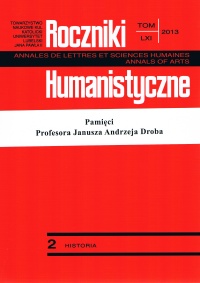What can the Lublin coat of arms mean?
Abstract
In the first part of the article a summary of the present state of research on the Lublin coat of arms is presented. On the basis of a discussion of the preserved impresses of a seal with this coat of arms the conclusion may be reached that in the whole Old Polish period until the end of the 18th century simultaneously two seals were used: ones that showed a goat only and ones showing a goat jumping on a vine. There is no basis then to think that the oldest preserved impress of a seal dating back to the beginning of the 15th century and showing only a goat was at the same time the oldest complete image of the Lublin coat of arms. In also must be stressed that the representation of the very goat should be considered a simplified version of the Lublin coat of arms, which from the very beginning could have presented a goat jumping on a vine. In the next part of the article a discussion is presented of the meaning of the Lublin coat of arms. Taking into consideration the Biblical (and also theological) meaning of the goat as well as that of the vine it may be recognized that the Lublin coat of arms means the Eucharist, Jesus Christ’s voluntary sacrifice, or a sacrifice of his life made by a martyr (the use of the motif of the goat and vine on the Gniezno Doors may suggest the person of St Adalbert here).
References
Chachaj J.: Bliżej schizmatyków niż Krakowa. Archidiakonat lubelski w XV i XVI wieku, Lublin 2012.
Chachaj J.: Początki kościołów lubelskich w świetle legend i przekazów historycznych, Lublin 2010.
Codex Aureus Gnesnensis (facsimile), [opr. T. Dobrzeniecki, A. Gieysztor], Warszawa 1986.
Garbaczewski W.: Ikonografia monet piastowskich 1173 – ok. 1280, Warszawa–Lublin 2007.
Gumowski M.: Pieczęcie i herby miejscowości województwa lubelskiego, Lublin 1959.
Gumowski M.: Sfragistyka, Warszawa 1960.
Kalinowski L.: Treści ideowe i estetyczne Drzwi gnieźnieńskich, w: Drzwi gnieźnieńskie, red. M. Walicki, t. II, Wrocław 1959, s. 7-146.
Kępiński Z.: Symbolika Drzwi gnieźnieńskich, w: Drzwi gnieźnieńskie, red. M. Walicki, t. II, Wrocław 1959, s. 161-283.
Kodeks dyplomatyczny Małopolski, wyd. F. Piekosiński, t. II, Kraków 1876.
Panfil T.: Herb Lublina, Lublin 1999.
Paszkiewicz B.: Święty Wojciech i monety, w: Środkowoeuropejskie dziedzictwo św. Wojciecha, red. A. Barciak, Katowice 1998.
Piechowski J.: Ukryte światła herbów, Warszawa 1991.
Ripa C.: Ikonologia, Kraków 2010.
Sztuka romańska. Architektura, rzeźba, malarstwo, red. R. Toman, Königswinter 2004.
Walicki M.: Kolegiata w Tumie pod Łęczycą, Łódź 1938.
Copyright (c) 2013 Roczniki Humanistyczne

This work is licensed under a Creative Commons Attribution-NonCommercial-NoDerivatives 4.0 International License.





